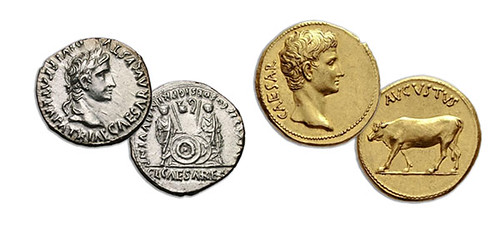
PREV ARTICLE
NEXT ARTICLE
FULL ISSUE
PREV FULL ISSUE
COINS OF THE TWELVE CAESARS
Mike Markowitz published a nice article on the coins of the Twelve Caesars in CoinWeek March 15, 2016. Here's an excerpt - be
sure to read the complete article online. -Editor
Julius Caesar
In 63 BCE he was elected Pontifex Maximus, high priest of the Roman state religion. Between 58 and 50 BCE Caesar conquered the Celtic tribes of Gaul, bridged the Rhine to fight the Germans and launched an expedition across the Channel into Britain. 
In 49, he began a civil war against the Roman Senate. To pay his armies he struck an immense issue of silver denarii bearing his name beneath an elephant on the obverse, and his “priestly implements” used in rituals on the reverse. These are by far the most common coins in Caesar’s name. Romans, who had overthrown their kings in 509 BCE to establish the Republic, were uncomfortable with the idea of depicting a living person on the coinage. In January 44 BCE, the first portrait coins in the name of Caesar were issued, with only the title IMP (for Imperator, which at this period meant only military commander-in-chief). A month later, portrait coins were struck with the title DICT PERPETUO (“Dictator for Life”). There are several variants of this type, bearing names of different mint officials (“moneyers”). For the conservative faction in the Senate, this was the last straw. On 15 March 44 BCE Caesar was stabbed to death. None of Caesar’s gold coins bear his portrait; many depict an uncertain female goddess (possibly Vesta). A particularly rare example struck by a military mint moving with Caesar’s army in 48-47 BCE sold for over $US300,000 in a recent European auction. Octavius, called Augustus

The assassination of Caesar renewed the civil war, which ended 17 years later when his great-nephew Octavius received the title of “Augustus” from the Senate. Gaius Octavius, son of Gaius Octavius, was born 23 September 63 BCE. His mother Atia was the daughter of Julia, sister of Julius Caesar. When Caesar was murdered Octavius was 18 years old, studying in Illyria (now Albania). He learned that he was Caesar’s adopted son and heir when he returned to Italy. Since Caesar had been deified (posthumously declared a god by the Senate on 1 Jan 42 BCE), Octavius used the title DIVI F (Divi filus “Son of a God”) on his imperial coinage. The most common silver issue of his long reign was struck between 2 BCE and 4 CE; it features a reverse depicting his grandsons and designated heirs, Lucius and Gaius. Unfortunately, Lucius died in 2 CE and Gaius died two years later, both possibly poisoned. Tiberius, the son of Octavius’s wife Livia by a previous marriage, succeeded him. On much of his elegant gold coinage the only inscription is the word AUGUSTUS. Although he lived to the age of 75 (remarkable for that era), his coin portrait remained youthful and idealized. A superb aureus of Augustus, with a reverse depicting a heifer, sold for nearly US$400,000 in a recent European auction. To read the complete article, see:

Wayne Homren, Editor The Numismatic Bibliomania Society is a non-profit organization promoting numismatic literature. See our web site at coinbooks.org. To submit items for publication in The E-Sylum, write to the Editor at this address: whomren@gmail.com To subscribe go to: https://my.binhost.com/lists/listinfo/esylum All Rights Reserved. NBS Home Page Contact the NBS webmaster 
|